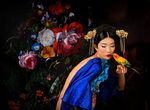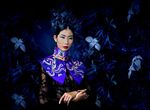Photographer Samantha Everton unveils Indochine, an exquisite new series exploring the confluence of Eastern and Western culture
←
→
Page content transcription
If your browser does not render page correctly, please read the page content below
MEDIA RELEASE February 2018 Photographer Samantha Everton unveils Indochine, an exquisite new series exploring the confluence of Eastern and Western culture From left: Samantha Everton Alabaster Pigment ink on cotton rag, 2018; Samantha Everton Xiao Majia Pigment ink on cotton rag, 2018 Acclaimed photographer Samantha Everton will this year present Indochine, a dynamic new exhibition series which explores the intersection of Western influences and Eastern traditions. The series will be unveiled at Arthouse Gallery in Sydney from 25 April to 19 May as part of Head On Photo Festival, and will launch at Anthea Polson Art in Queensland from 16 June to 30 June 2018. Indochine depicts a woman navigating the conflicting cultural pressures of the East and the West. Exuding visual luxury and vivid sensuality, the artworks plunge the viewer into a colour-saturated dreamscape. The series explores the encroachment of Western fashion within Asian cultures and the struggle for authenticity amidst contemporary influences. Behind the amplified colouration and ornamental intricacies are symbolic elements that offer clues to the underlying stories. Everton's talent is to reveal what lies hidden, and in the portraits can be found fragility and adaptability, vulnerability and resilience, compliance and resolute self-expression. The women captured are torn between the cultural values and expectations of their times and a deep interior struggling towards individuality. Informed by the artist’s multi-cultural upbringing, with three adopted Asian siblings, Indochine explores identity and how Western influences have intersected with Eastern traditions and values. It also touches on the methods available to women to express a changing cultural identity by altering their appearance. While such shifts are sometimes presumed to be a relatively new phenomenon, the artworks explore how this blending of Eastern and Western cultures has been happening perceptibly for centuries. The Melbourne-based artist has won multiple photographic and fine art awards and had her work exhibited widely in Australia and internationally, including Paris and New York galleries. Everton is widely known for her commitment to photographic authenticity and her ambitious production processes. This series is no exception. Shot in Ho Chi Minh City, Vietnam, the works were created over an eighteen-month period involving international collaboration, extensive research into fashion and set design, and overseas travel. Everton went to extraordinary lengths to source the couture costumes, hand-crafted jewellery and relevant props to bring her artistic vision to life. Everton also worked with a long list of skilled artisans. She handpicked Larry Edwards, the Head costume designer for Cirque Du Soleil, to design and handcraft the elaborate period collars. The artist also commissioned an artisan in Greece and the UK, a set assistant and a seamstress in Saigon to construct the painstakingly detailed bodices and costumes, as well as an artist in China who hand- painted the bespoke Chinoiserie wallpapers.
The set featured a live yellow albino Burmese python and a macaw bird as portrait props. The rare two and a half metre-long snake was brought onto set by a Saigon python handler, and draped precariously around the model. The exotic bird was sourced through macaw enthusiasts who met fortnightly at a Saigon café and agreed to lend the bird to the artist. Its dazzlingly rainbow-coloured feathers capture the viewer’s attention in the Jacquerie portrait. Another notable feature of the shoot is Everton’s focus on authenticity of image, as the artist favours a cinematic style of photography over post-production techniques. “Everything I create is in camera. This means that no montaging happens after production. Everything you see was there: the python and macaw, detailed backgrounds, shafts of light, and intense colours,” said Everton. “I often feel like I’m a director of a production, rather than a photographer, as I’m rarely behind the camera for long during a shoot. I’m in front of the camera; fine tuning and refining every aspect of the detailed and elaborate sets before the shutter is pressed,” adds the artist. Everton’s Alabaster image explores the strict social stature and moral values which governed the Elizabethan era. During the 1580s neck ruffs were in vogue, intended to draw the onlookers’ gaze towards the face. Expanding ever outwards and upwards the ruffs became increasingly restrictive for the wearer, making it difficult to relax, or even eat in one. The model’s face is slathered with thick white make-up, to achieve the desirable pale complexion reminiscent of the era. Pearls that were in those days symbolic of purity and loyalty adorn her hair. Is the strand dangling from an outstretched hand a sign of proffered adherence or willful rejection of such? Slashes of rouge directing one’s attention to the scarlet pouting lips perhaps suggest the latter. The Jacquerie image portrays a woman in a striking pose against the dark background of a swirling fern motif. A macaw takes flight from her left hand, brilliantly coloured feathers fanned out across her face. In folkloric traditions the macaw is considered to be a bridge between the human and animal worlds, allowing both to cross and to live in harmony. The macaw’s presence serves as an allusion to the need for both eastern and western cultures to come together. The macaw also engenders personal aspirations towards something ‘better’. The model’s eyes stare unflinchingly at the viewer. This is the moment where she transforms from the submissive traditional figure to a more confident individual. The prim whiteness of a delicate Victorian lace collar clashes with her features, heightening its incongruity. The Xiao Majia portrait is a symbolic work depicting 1920s Shanghai, an era when Western Influences were rife. In this image is a woman adorned in a crown of black roses with a meditative expression. Behind her is an entanglement of white orchid-strewn foliage. Coloured orchids in Chinese lore denote springtime and often festoon wedding and religious ceremonies. White orchids, however, have a more sombre significance, as do black roses. Both portend farewells and endings, but as such, they also herald rebirth or the beginnings of something new. The dragon embroidered upon the model’s breastplate is an archetypal symbol of transformation. In China the dragon was considered an auspicious creature bestowing the perseverance to overcome any obstacle. Xiao Majia translates as 'Little Vest'. It refers to the heavy long collar-like plates adopted by high-ranking Chinese women when the centuries-old practice of breast binding ended in the 1920s. Fast-forward to the 21st century where cyber technology has homogenised cultural perspectives and largely invalidated age-old traditions for the young. The Femme Fatale image playfully highlights an extreme of ‘East meets West’ exchange. Manga comic-like in her unnaturally pale skin, mirroring the de-racialisation effect in the Elizabeth portrait, white hair and wide blue eyes, this young Asian woman impassively addresses her audience. Unlike the mysterious and dark femmes fatales of the film noir era, this image playfully twists the concept on its head. There are references to both Britney Spears – who released an album entitled Femme Fatale, and famously performed live with an albino Burmese python draped over her shoulders – and Rhianna, who wore $9000 bejewelled Dolce and Gabanna headphones. The figure here seems almost disinterested in the python, while her headphones are encrusted not with jewels, but comic symbols of materialistic pursuits: a purple toy car, my little pony effigies and a fluffy flamingo. Truong Son is the final and least embellished image in the portrait series: the setting is understated. The woman’s head tilts to the side, a lock of pink hair brushes her face. Blue eyes and a simple collared blouse combined with a direct gaze and nonchalant posture. The portrait hints at a woman who is ultimately at ease within herself.
MEDIA IMAGERY Indochine: Artworks by Samantha Everton Samantha Everton huā niǎo Pigment ink on cotton rag, 2018 Samantha Everton Femme Fatale Pigment ink on cotton rag, 2018
Samantha Everton Jacquerie Pigment ink on cotton rag, 2018 Samantha Everton Chinoiserie Pigment ink on cotton rag, 2018 Samantha Everton Truong Son Pigment ink on cotton rag, 2018
ABOUT THE ARTIST Born in Whyalla, South Australia, and raised in central Queensland Samantha Everton credits her unusual childhood as instrumental in fostering a creative mind. Growing up with a biological brother and three adopted Asian siblings, Everton spent hours fossicking for gemstones under the wide blue skies of remote mining towns. Hers was a colour-saturated world. Although not directly referencing her own family experience, multicultural themes and notions of identity continue to influence much of her imagery. Everton graduated with a Photographic Design Degree, RMIT 2003 and subsequently achieved success in a great number of prestigious awards including Px3 Paris International Photography Awards (2010, 2014), Moran Contemporary Art Prize (Highly Commended 2009), London International Creative Competition (2010), the Photography Master Cup International Colour Awards (2013) and the Head On Photo Awards (2015). Everton has exhibited widely, with more than twenty solo exhibitions to her name, across Australia and internationally. 2018 EXHIBITION DETAILS 25 April – 19 May 2018 17 June – 30 June 2018 Arthouse Gallery Anthea Polson Art 66 McLachlan Avenue, Rushcutters Bay NSW Shop 120 Marina Mirage, Seaworld Drive, 2011 Main Beach, QLD 4217 Ph: 02 9332 1019, W Ph: 07 5561 1166, W www.arthousegallery.com.au www.antheapolsonart.com.au Gallery hours: Tue-Fri 9.30am-6pm and Sat: Gallery Hours: 10.00am-6pm 10.00am-5pm ABOUT HEAD ON PHOTO FESTIVAL: Running from Saturday 5 – Sunday 20 May 2018, Head On Photo Festival is one of the world’s most prestigious photo festivals. Since it began in 2010 the Festival has evolved to include a wide range of stunning exhibitions from world renowned photographers, innovative workshops run by international professionals and critically acclaimed mentors and community events aimed at everyone from enthusiasts and devout collectors. MEDIA CONTACTS: Media enquiries for Samantha Everton artworks: Gabrielle Wilson 0433 972 915 or gabrielle@thepresssociety.com.au Media enquiries for Head On Photo Festival: Matt Fraser 0401 326 007 or matt@cardinalspin.com.au
You can also read
























































